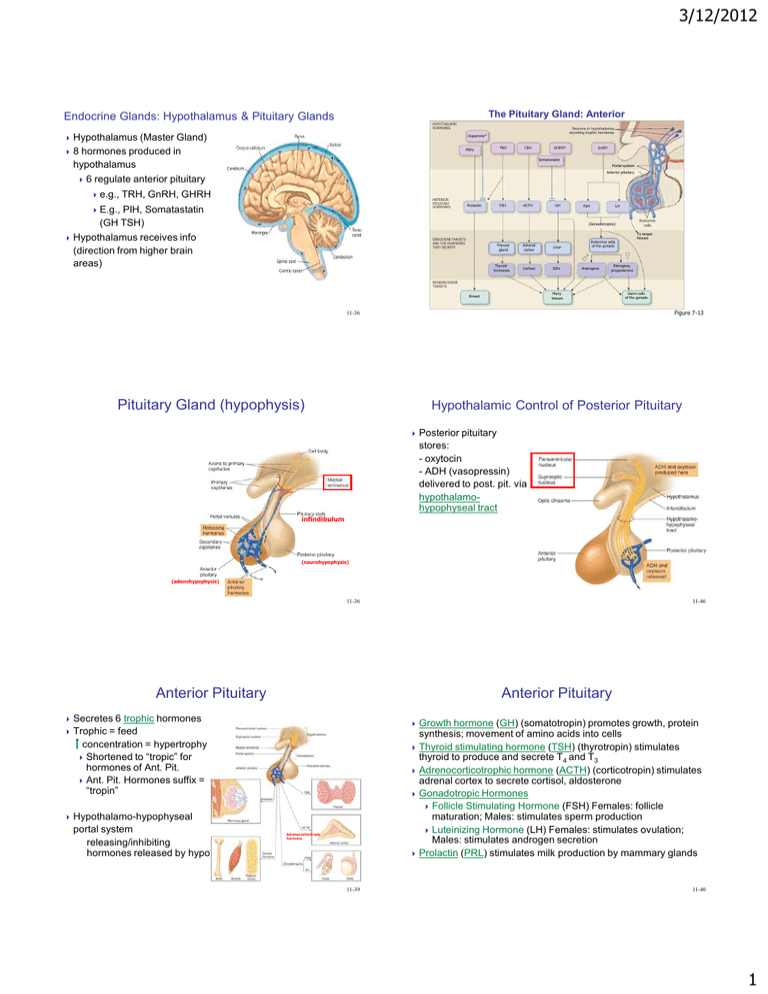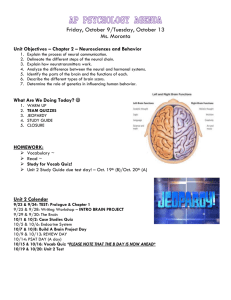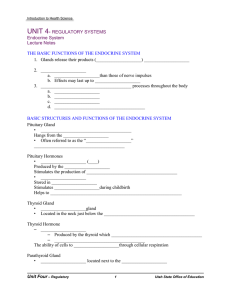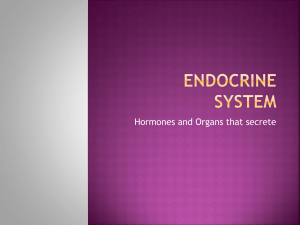3/12/2012 Endocrine Glands: Hypothalamus & Pituitary Glands
advertisement

3/12/2012 The Pituitary Gland: Anterior Endocrine Glands: Hypothalamus & Pituitary Glands HYPOTHALAMIC HORMONES Neurons in hypothalamus secreting trophic hormones Dopamine* Hypothalamus (Master Gland) 8 hormones produced in hypothalamus TRH PRFs CRH GHRH* GnRH Somatostatin Portal system Anterior pituitary 6 regulate anterior pituitary e.g., TRH, GnRH, GHRH ANTERIOR PITUITARY HORMONES E.g., PIH, Somatastatin (GH TSH) TSH Prolactin ACTH GH FSH LH Endocrine cells (Gonadotropins) Hypothalamus receives info ENDOCRINE TARGETS AND THE HORMONES THEY SECRETE (direction from higher brain areas) Thyroid gland Adrenal cortex Liver Thyroid hormones Cortisol IGFs To target tissues Endocrine cells of the gonads Androgens Estrogens, progesterone NONENDOCRINE TARGETS Many tissues Breast Figure 7-13 11-36 Pituitary Gland (hypophysis) Germ cells of the gonads Hypothalamic Control of Posterior Pituitary Posterior pituitary stores: - oxytocin - ADH (vasopressin) delivered to post. pit. via hypothalamohypophyseal tract infindibulum (neurohypophysis) (adenohypophysis) 11-36 11-46 Anterior Pituitary Anterior Pituitary Secretes 6 trophic hormones feed concentration = hypertrophy Shortened to “tropic” for hormones of Ant. Pit. Ant. Pit. Hormones suffix = “tropin” Growth hormone (GH) (somatotropin) promotes growth, protein synthesis; movement of amino acids into cells Thyroid stimulating hormone (TSH) (thyrotropin) stimulates thyroid to produce and secrete T4 and T3 Adrenocorticotrophic hormone (ACTH) (corticotropin) stimulates adrenal cortex to secrete cortisol, aldosterone Gonadotropic Hormones Follicle Stimulating Hormone (FSH) Females: follicle maturation; Males: stimulates sperm production Luteinizing Hormone (LH) Females: stimulates ovulation; Males: stimulates androgen secretion Prolactin (PRL) stimulates milk production by mammary glands Trophic = Hypothalamo-hypophyseal portal system releasing/inhibiting hormones released by hypo. Adrenocorticotropic hormone 11-39 11-40 1 3/12/2012 Feedback Control of Anterior Pituitary Adrenal Glands Adrenal Medulla synthesizes and secretes 80% Epinephrine and 20% Norepinephrine Controlled by sympathetic division of ANS - Recall preganglionic neuron stimulation! Adrenal Cortex No neural innervation!! i.e., stimulated by ACTH Releases Steroid hormones (corticosteriods = corticoids) 11-43 11-48 Adrenal Glands Adrenal Medulla & Norepi. released in ~ 4:1 ratio preganglionic Sympathetic fibers Activated during "fight or flight" response Causes: Increased respiratory rate Increased HR and cardiac output General vasoconstriction which increases venous return Glycogenolysis and lipolysis Adrenal Cortex is controlled by ACTH and secretes: Steroid hormones (corticosteriods) 3 functional groups: Epi. Innervated by 11-51 1. Mineralcorticoids (regulate Na+/K+ balance) - e.g. aldosterone (Na+ H20 retained/ K+ excreted) increases blood volume & pressure 2. Glucocorticoids: carb!!!!!/protein/fat metabolism - e.g. Cortisol (hydrocortisone): - stimulates gluconeogenesis (glucose from non-carbs) - inhibit glucose utilization (raises blood glucose) - promotes lipolysis (raises free fatty acids in blood) - dampen inflammation & immune response! - exogenous gluccocorticoids (pills, shots, creams) 3. Sex steriods (weak androgens) Stress and the Adrenal Gland Under stress – ACTH increases thus adrenal cortex secretes more glucocorticoids Stress induces a nonspecific response called general adaptation syndrome (GAS) 3 stages in response to stress 1. Alarm reax: adrenal glands activated (epi. & cortisol) 2. Resistance: readjustment occurs (glycogen used, body uses alternative fuels (pro. & fat breakdown for gluconeogenesis but glucose uptake is inhibited - Immune response inhibited 3. Exhaustion 11-49 Stress and the Adrenal Gland Chronic stress can induce high levels of cortisol that cause a number of negative effects: atrophy of hippocampus (involved in memory) reduced sensitivity of tissues to insulin (insulin resistance) inhibition of vagus nerve activity suppression of growth hormone, thyroid hormone, and gonadotropins Dampened immune response Pituitary-Adrenal Axis 11-52 11-53 2 3/12/2012 Thyroid Gland Located just Thyroid Gland below the larynx Secretes T4 (tetraiodothyronine – aka thyroxine) T3 (triiodothyronine) set BMR and needed for growth, development Calcitonin: Lowers blood Ca+ Consists of microscopic thyroid follicles (follicle cells) synthesize T4 Interior is protein-rich colloid fluid Outer layer Recall Thyroid Hormones: carried in blood Stimulate protein synthesis Protein carriers 11-55 Production of Thyroid Hormones Hypothyroidism: Inadequate T4 and T3 levels (hypothyroid) or TSH weight gain, lethargic, cold intolerance myxedema = puffy face, hands, feet Goiter! Hyperthyroidism: Grave's disease Autoimmune disease where antibodies stimulate thyroid gland to grow and oversecrete Bulging eyes, weight loss, heat intolerance, irritability, high BMR (I-) actively transported into colloid oxidized to iodine (I2) and attached thyroglobulin Iodide MIT & DIT then used to make T3 andT4 11-56 Low BMR, (Protein rich fluid) TSH stimulates hormones to be taken in by follicular cells and removed from thyroglobulin 11-59 Parathyroid Glands Parathyroid Hormone Stimulated by decreased blood Ca2+ Acts on bones, kidney, and intestines Bones; increases osteoclast activity Kidney: Ca+ reabsorption Intestines: increased Ca+ absorption ALL increase blood Ca+ 4 glands: posterior lateral lobes of thyroid gland Secrete Parathyroid hormone (PTH) Raises blood Ca2+ levels 11-62 11-63 3 3/12/2012 Correction for Hypercalcemia Correction for Hypocalcemia Blood Ca2+ excess Blood Ca2+ returns to normal Blood Ca2+ returns to normal Blood Ca2+ deficiency Parathyroid hormone secretion Calcitonin (Thyroid Gland) secretion Reduced osteoclast activity Less bone resorption Increased osteoblast activity More bone deposition 7-19 Increased osteoclast activity More bone resorption Reduced osteoblast activity Less bone deposition More urinary phosphate excretion Prevention of hydroxyapatite formation Less urinary calcium excretion Conservation of calcium (b) Correction for hypocalcemia Pancreas Figure 7.18b 7-20 Islets of Langerhans Islets of Langerhans Scattered clusters of endocrine cells in pancreas -alpha and beta cells Alpha cells secrete horomone glucagon in response to low blood glucose Stimulates glycogenolysis and lipolysis Increases blood glucose Beta cells secrete insulin in response to high blood glucose 1. Promotes entry of glucose into cells 2. Conversion of glucose into glycogen and fat Both decrease blood glucose 11-67 Diabetes mellitus: Type 1 insulin-dependent: -Beta cells don’t secrete insulin Type 2 non insulindependent (more common) : - tissue loses sensitivity for insulin i.e., need more for normal effect Primarily in Skeletal muscle, Liver, and adipose tissue (glycogen to glucose) (non-carbs to glucose) 4 3/12/2012 Pineal Gland Pineal Gland and Melatonin Located epithalamus Secretes melatonin in response to activity of suprachiasmatic nucleus of hypothalamus Daylight inhibits SCN reducing sympathetic stimulation of Pineal gland. Figure 7-22 (2 of 3) 11-69 Sex and Reproductive Hormones GI Tract A number of GI organs produce hormones: Stomach Small intestine Act on GI tract itself, gallbladder, and pancreas Act in concert with ANS to coordinate regions of GI tract and pancreatic juice and bile Gonads (testes and ovaries) secrete sex steroid hormones: Androgens (testosterone) - semineferous tubules = spermies - leydig cells = testosterone Estrogens & Progesterone Estrogens Placenta secretes estrogen, progesterone, hCG, and somatomammotropin 11-72 Autocrine and Paracrine Regulation Autocrine Regulators: Prostaglandins (PGs) Autocrine regulators: Chemicals produced in a cell and have an effect on same cell All autocrines control gene expression in target cells Produced in Paracrine regulators produced by tissue of an organ and act on different cells of the same organ A almost every organ to eicosanoid family -- all derived from arachidonic acid of plasma membrane Hormones or other agents stimulate release of arachidonic acid from membrane PGs have wide variety of functions Different PGs may exert antagonistic effects in tissues Some promote smooth muscle contraction and some relaxation Some promote clotting; some inhibit Promotes inflammatory process of immune system Plays role in ovulation Inhibits gastric secretion in digestive system Belong chemical can function as both and paracrines include: Cytokines (lymphokines, interleukins) - stimulate (regulate), proliferation of cells of immune system Growth factors (promote growth and cell division) Neutrophins (provides trophic support for neurons) Autocrines 11-74 11-75 5 3/12/2012 Autocrine Regulators: Prostaglandins (PGs) Cyclooxygenase (COX) needed for PG synthesis Prostaglandin inhibitors: non-steroidal anti-inflammatory drugs (NSAIDs) inhibit COX i.e, drugs inhibit inflamation!!!!!!!!!!!!!!!! 11-75 6







